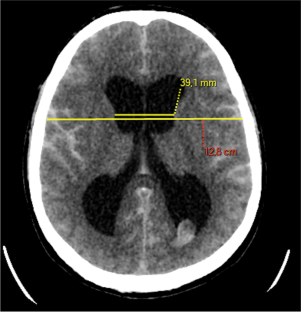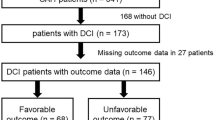Abstract
Background
Delayed cerebral infarction (DCIn) following aneurysmal subarachnoid hemorrhage (aSAH) is a major cause of morbi-mortality; yet, the causes for DCIn remain incompletely understood.
Objective
We tested the hypothesis that acute hydrocephalus could be related to the occurrence of DCIn, independently of the occurrence and severity of vasospasm.
Methods
Radiological and clinical data of patients treated at a single large volume academic center for aSAH between 2017 and 2019 were retrospectively analyzed. DCIn was defined as imaging stigma of cerebral infarction visible on 6-week imaging follow-up after aSAH. Hydrocephalus was defined on baseline imaging as a relative bicaudate index above 1. Cerebral vasospasm was defined by reduction of artery diameter in comparison with initial diameter. We used uni- and multivariable models to test the associations between these variables, hydrocephalus and DCIn.
Results
Of 164 included patients, vasospasm occurred in 58 patients (35.4%), and DCIn in 47 (28.7%). Acute hydrocephalus was present in 85 patients (51.8%) on baseline CT. No relation was found between acute hydrocephalus and delayed cerebral infarction in our multivariate analysis (adjusted OR: 1.20 95% CI [0.43–3.37]; p = 0.732). Only vasospasm occurrence was independently associated with DCIn (adjusted OR: 10.97 95% CI [4.60–26.01]).
Conclusion
Our study did not show an association between acute hydrocephalus and DCIn after aSAH, after adjustment for the presence and severity of cerebral vasospasm.



Similar content being viewed by others
Abbreviations
- SAH:
-
Subarachnoid hemorrhage
- aSAH:
-
Aneurysmal subarachnoid hemorrhage
- DCI:
-
Delayed cerebral ischemia
- DCIn:
-
Delayed cerebral infarction
- CT:
-
Computed tomography
- MRI:
-
Magnetic resonance imaging
- WFNS:
-
World federation of neurosurgical surgery
- BCI:
-
Bicaudate index
- rBCI:
-
Relative bicaudate index
- EVD:
-
External ventricular drainage
References
Bakker AM, Dorhout SM, Algra A, Rinkel GJ (2007) Extent of acute hydrocephalus after aneurysmal subarachnoid hemorrhage as a risk factor for delayed cerebral infarction. Stroke 38:2496–2499. https://doi.org/10.1161/STROKEAHA.107.484220
Balbi M, Koide M, Schwarzmaier SM, Wellman GC, Plesnila N (2017) Acute changes in neurovascular reactivity after subarachnoid hemorrhage in vivo. J Cereb Blood Flow Metab 37(1):178–187. https://doi.org/10.1177/0271678X15621253
Black PM (1986) Hydrocephalus and vasospasm after subarachnoid hemorrhage from ruptured intra-cranial aneurysms. Neurosurgery 18:12–16. https://doi.org/10.1227/00006123-198601000-00003
Bosche B, Graf R, Ernestus R-I, Dohmen C, Reithmeier T, Brinker G, Strong AJ, Dreier JP, Woitzik J (2010) Recurrent spreading depolarizations after subarachnoid hemorrhage decreases oxygen availability in human cerebral cortex. Ann Neurol 67(5):607–617. https://doi.org/10.1002/ana.21943
Bosche B, Mergenthaler P, Doeppner TR, Hescheler J, Molcanyi M (2019) Complex clearance mechanisms after intraventricular hemorrhage and rt-PA treatment – a review on clinical trials. Transl Stroke Res. https://doi.org/10.1007/s12975-019-00735-6
Boulouis G, Labeyrie MA, Raymond J, Rodriguez-Régent C, Lukaszewicz AC, Bresson D, Ben Hassen W, Tristram D, Meder JF, Oppenheim C, Naggara O (2017) Treatment of cerebral vasospasm following aneurysmal subarachnoid haemorrhage: a systematic review and meta-analysis. Eur Radiol 27(8):3333–3342. https://doi.org/10.1007/s00330-016-4702-y
Brami J, Chousterman B, Boulouis G, Le Dorze M, Majlath M, Saint-Maurice JP, Civelli V, Froelich S, Houdart E, Labeyrie MA (2020) Delayed cerebral infarction is systematically associated with a cerebral vasospasm of large intracranial arteries. Neurosurgery 86(2):E175–E183. https://doi.org/10.1093/neuros/nyz340
Bretz JS, Von Dincklage F, Woitzik J, Winkler MK, Major S, Dreier JP, Bohner G, School M (2017) The Hijdra scale has significant prognostic value for the functional outcome of Fisher grade 3 patients with subarachnoid hemorrhage. Clin Neuroradiol 27(3):361–369. https://doi.org/10.1007/s00062-016-0509-0
Brouwers PJ, Dippel DW, Vermeulen M, Lindsay KW, Hasan D, van Gijn J (1993) Amount of blood on computed tomography as an independent predictor after aneurysm rupture. Stroke 24:809–814. https://doi.org/10.1161/01.str.24.6.809
Budohoski KP, Guilfoyle M, Helmy A, Huuskonen T, Czosnyka M, Kirollos R, Menon DK, Pickard JD, Kirkpatrick P (2014) The pathophysiology and treatment of delayed cerebral ischaemia following subarachnoid haemorrhage. J Neurol Neurosurg Psychiatry 85(12):1343–1353. https://doi.org/10.1136/jnnp-2014-307711
Chen S, Lou J, Reis C, Manaenko A, Zhang J (2017) Hydrocephalus after subarachnoid hemorrhage: pathophysiology, diagnosis, and treatment. Biomed Rest Int 2017:8584753. https://doi.org/10.1155/2017/8584753
Dakson A, Kameda-Smith M, Staudt MD, Lavergne P, Makarenko S,Eagles ME, Ghayur H, Guo RC, Althagafi A, Chainey J, Touchette CJ, Elliott C, Iorio-Morin C, Tso MK, Green R Bargone L, Christie SD (2021) A nationwide prospective multicenter study of external ventricular drainage: accuracy, safety, and related complications. J Neurosurg: 1–9. https://doi.org/10.3171/2021.7.JNS21421.
Ditz C, Leppert J, Neumann A, Krajewski KL, Gliemroth J, Tronnier VM, Küchler J (2020) Cerebral vasospasm following spontaneous subarachnoid hemorrhage: angiographic pattern and its impact on the clinical course. World Neurosurg 138:e913–e921. https://doi.org/10.1016/j.wneu.2020.03.146
Dong L, Zhou Y, Wang M, Yang C, Yuan Q, Fang X (2019) Whole-brain CT perfusion on admission predicts delayed cerebral ischemia following aneurysmal subarachnoid hemorrhage. Eur J Radiol 116:165–173. https://doi.org/10.1016/j.ejrad.2019.05.008
Dorsch NW, King MT (1994) A review of cerebral vasospasm in aneurysmal subarachnoid haemorrhage part I: incidence and effects. J Clin Neurosci 1(1):19–26. https://doi.org/10.1016/0967-5868(94)90005-1
Dupont SA, Wijdicks FM, Manno EM, Lanzino G, Rabinstein A (2009) Prediction of angiographic vasospasm after aneurysmal subarachnoid hemorrhage: value of the Hijdra sum scoring system. Neurocrit Care 11(2):172–176. https://doi.org/10.1007/s12028-009-9247-3
Etminan N, Beseoglu K, Heiroth HJ, Turowski B, Steiger HJ, Hanggi D (2013) Early perfusion computerized tomography imaging as a radiographic surrogate for delayed cerebral ischemia and functional outcome after subarachnoid hemorrhage. Stroke 44:1260–1266. https://doi.org/10.1161/STROKEAHA.111.675975
Fugate JE, Rabinstein AA, Wijdicks EF, Lanzoni G (2012) Aggressive CSF diversion reverses delayed cerebral ischemia in aneurysmal subarachnoid hemorrhage: a case report. Neurocrit Care 17:112–116. https://doi.org/10.1007/s12028-012-9723-z
Hammer A, Erbguth F, Hohenhaus M, Hammer CM, Lücking H, Gesslein M, Killer-Oberpfalzer M, Steiner HH, Janssen H (2021) Neurocritical care complications and interventions influence the outcome in aneurysmal subarachnoid hemorrhage. BMC Neurol 21(1):27. https://doi.org/10.1186/s12883-021-02054-6
Hammer A, Erbguth F, Hohenhaus M, Hammer CM, Lücking H, Gesslein M, Killer-Oberpfalzer M, Steiner HH, Janssen H (2021) Neurocritical care complications and interventions influence the outcome in aneurysmal subarachnoid hemorrhage. BMC Neurol 21:27. https://doi.org/10.1186/s12883-021-02054-6
Hasan D, Tanghe HL (1992) Distribution of cisternal blood in patients with acute hydrocephalus after subarachnoid hemorrhage. 31(4):374-8. https://doi.org/10.1002/ana.410310405
Hijdra A, van Gijn J, Nagelkerke NJ, Vermeulen M, van Crevel H (1988) Prediction of delayed cerebral ischemia, rebleeding, and outcome after aneurysmal subarachnoid hemorrhage. Stroke 19:1250–1256. https://doi.org/10.1161/01.str.19.10.1250
Hirashima Y, Hamada Y, Hamada H, Hayashi N, Kuwayama N, Origasa H, Endo S (2003) Independent predictors of late hydrocephalus in patients with aneurysmal subarachnoid hemorrhage – analysis by multivariate logistic regression model. Crebrovasc Dis 16(3):205–210. https://doi.org/10.1186/s13037-018-0160-6
Hop JW, Rinkel GJ, Algra A, van Gijn J (1999) Initial loss of consciousness and risk of delayed cerebral ischemia after aneurysmal subarachnoid hemorrhage. Stroke 30:2268–2271. https://doi.org/10.1161/01.str.30.11.2268
Jingjing L, Nan J, Zhonghua Y, Xingquan Z (2012) Prognosis and treatment of acute hydrocephalus following aneurysmal subarachnoid haemorrhage. J Clin Neurosci 19(5):669–72. https://doi.org/10.1016/j.jocn.2011.06.032
Lindvall P, Runnerstam M, Birgander R, Koskinen LO (2009) The Fisher grading correlated to outcome in patients with subarachnoid haemorrhage. Br J Neurosurg 23(2):188–192. https://doi.org/10.1080/02688690802710668.Sano
MacDonald RL (2014) Delayed neurological deterioration after subarachnoid haemorrhage. Nat Rev Neurol 10(1):44–58. https://doi.org/10.1038/nrneurol.2013.246
Nakagawa I, Hironaka Y, Nishimura F (2013) Early inhibition of natriuresis suppresses symptomatic cerebral vasospasm in patients with aneurysmal subarachnoid hemorrhage. Cerebrovasc Dis 35:131–137. https://doi.org/10.1159/000346586
Neifert SN, Chapman EK, Martini ML, Shuman WH, Schupper AJ, Oermann EK, Mocco J, Macdonald RL (2021) Aneurismal subarachnoid hemorrhage: the last decade. Trans Stroke Res 12(3):428–446. https://doi.org/10.10007/s12975-020-00867-0
Roos YB, de Haan RJ, Beenen LF, Groen RJ, Albrecht KW, Vermeulen M (2000) Complications and outcome in patients with aneurysmal subarachnoid haemorrhage: a prospective hospital-based cohort study in The Netherlands. J Neurol Neurosurg Psychiatry 68(3):337–341. https://doi.org/10.1136/jnnp.68.3.337
Rowland MJ, Hadjipavlou G, Kelly M, Westbrook J, Pattinson KTS (2012) Delayed cerebral ischaemia after subarachnoid haemorrhage: looking beyond vasospasm. Br J Anaesth 109(3):315–329. https://doi.org/10.1093/bja/aes264
Sehba FA, Ryszard JH, Pluta M, Zhang JH (2012) The importance of early brain injury after subarachnoid hemorrhage. Prog Neurobiol 97(1):14–37. https://doi.org/10.1016/j.pneurobio.2012.02.003
Starnoni D, Maduri R, Hajdu SD, Pierzchala K, Giammattei L, Rocca A, Grosfilley SB, Saliou G, Messerer M, Roy (2019) Early perfusion computed tomography scan for prediction of vasospasm and delayed cerebral ischemia after aneurysmal subarachnoid hemorrhage. World Neurosurg 130:e743–e752. https://doi.org/10.1016/j.wneu.2019.06.213
van Asch CJ, van der Schaaf IC, Rinkel GJ (2010) Acute hydrocephalus and cerebral perfusion after aneurysmal subarachnoid hemorrhage. Am J Neuroradiol 31(1):67–70. https://doi.org/10.3174/ajnr.A1748
van Gijn J, Hijdra A, Wijdicks FM, Vermeulen M, Van Crevel H (1985) Acute hydrocephalus after aneurysmal subarachnoid hemorrhage. J Neurosurg 63(3):355–362. https://doi.org/10.3171/jns.1985.63.3.0355
Van der Steen WE, Leemans EL, van den Berg R, Roos YB, Marquering HA, Verbaan D, Majoie C (2019) Radiological scales predicting delayed cerebral ischemia in subarachnoid hemorrhage: systematic review and meta-analysis. Neuroradiology 61(3):247–256. https://doi.org/10.1007/s00234-019-02161-9
Vergouwen MDI, Vermeulen M, van Gijn J, Rinkel GJE, Wijdicks EF, Muizelaar JP, Mendelow AD, Juvela S, Yonas H, Terbrugge KG, Macdonald RL, Diringer MN, Broderick JP, Dreier JP, Roos YBWEM (2010) Definition of delayed cerebral ischemia after aneurysmal subarachnoid hemorrhage as an outcome event in clinical trials and observational studies: proposal of a multidisciplinary research group. Stroke 41:2391–2395. https://doi.org/10.1161/STROKEAHA.110.589275
Weidauer S, Lanfermann H, Raabe A, Zanella F, Seifert V, Beck J (2007) Impairment of cerebral perfusion and infarct patterns attributable to vasospasm after aneurysmal subarachnoid hemorrhage: a prospective MRI and DSA study. Stroke 38(6):1831–1836. https://doi.org/10.1161/STROKEAHA.106.477976
Yoshino M, Yoshimi Y, Taniguchi M, Nakamura S, Ikeda T (1999) Syndrome of inappropriate secretion of antidiuretic hormone associated with idiopathic normal pressure hydrocephalus. Intern Med 38(3):290–292. https://doi.org/10.2169/internalmedicine.38.290
Zhong Y, Xin H, Chao Y (2017) Endovascular therapy for vasospasm secondary to subarachnoid hemorrhage: a meta-analysis and systematic review. Clin Neurol Neurosurg 163:9–14. https://doi.org/10.1016/j.clineuro.2017.09.016
Author information
Authors and Affiliations
Corresponding authors
Ethics declarations
Ethical approval
All procedures performed in studies involving human participants were in accordance with the ethical standards of the institutional and national research committee and with the 1964 Helsinki declaration and its later amendments or comparable ethical standards. This article does not contain any studies with animals performed by any of the authors.
Consent to participate
Informed consent was obtained from all individual participants included in the study.
Conflict of interest
Axel Masson declares that he has no conflict of interest.
Grégoire Boulouis declares that he has no conflict of interest.
Kévin Janot declares that he has no conflict of interest.
Denis Herbreteau declares that he has no conflict of interest.
Jean-Philippe Cottier declares that he has no conflict of interest.
Richard Bibi declares that he has no conflict of interest.
Clara Cohen declares that she has no conflict of interest.
Sandra Obry declares that she has no conflict of interest.
Stéphane Velut declares that he has no conflict of interest.
Aymeric Amelot declares that he has no conflict of interest.
Héloïse Ifergan declares that she has no conflict of interest.
Additional information
Publisher's note
Springer Nature remains neutral with regard to jurisdictional claims in published maps and institutional affiliations.
This article is part of the Topical Collection on Vascular Neurosurgery - Aneurysm
Rights and permissions
Springer Nature or its licensor holds exclusive rights to this article under a publishing agreement with the author(s) or other rightsholder(s); author self-archiving of the accepted manuscript version of this article is solely governed by the terms of such publishing agreement and applicable law.
About this article
Cite this article
Masson, A., Boulouis, G., Janot, K. et al. Acute hydrocephalus and delayed cerebral infarction after aneurysmal subarachnoid hemorrhage. Acta Neurochir 164, 2401–2408 (2022). https://doi.org/10.1007/s00701-022-05321-8
Received:
Accepted:
Published:
Issue Date:
DOI: https://doi.org/10.1007/s00701-022-05321-8




